LACOSTE: Analysis of Strategies for a Diverse and Inclusive Workforce
VerifiedAdded on 2023/01/19
|28
|4066
|59
Report
AI Summary
This project report examines LACOSTE's strategies for building a diverse and inclusive workforce, focusing on recruitment, selection, and training processes. It begins with an introduction highlighting the importance of effective employee management for organizational success in the global market. The aim is to identify the best strategies and initiatives employed by LACOSTE to foster a diverse and inclusive workforce, with objectives including exploring current strategies, discovering new initiatives, and recommending improvements. The report includes a literature review discussing various strategies used by multinational companies to build a diverse workforce, emphasizing the importance of innovation, equality, and a strong company culture. A project management plan is developed, covering costs, scope, time, quality, communication, and risks. Qualitative and quantitative research methods are used, including primary and secondary data collection, with a sample size of 40 respondents. Data analysis is performed, and findings are presented through themes, interpretations, and supporting data, highlighting the importance of appropriate recruitment, selection, training and methods. The research aims to provide valuable insights into improving LACOSTE's workforce diversity and inclusivity practices.

Managing a Successful
Business Project
Business Project
Paraphrase This Document
Need a fresh take? Get an instant paraphrase of this document with our AI Paraphraser
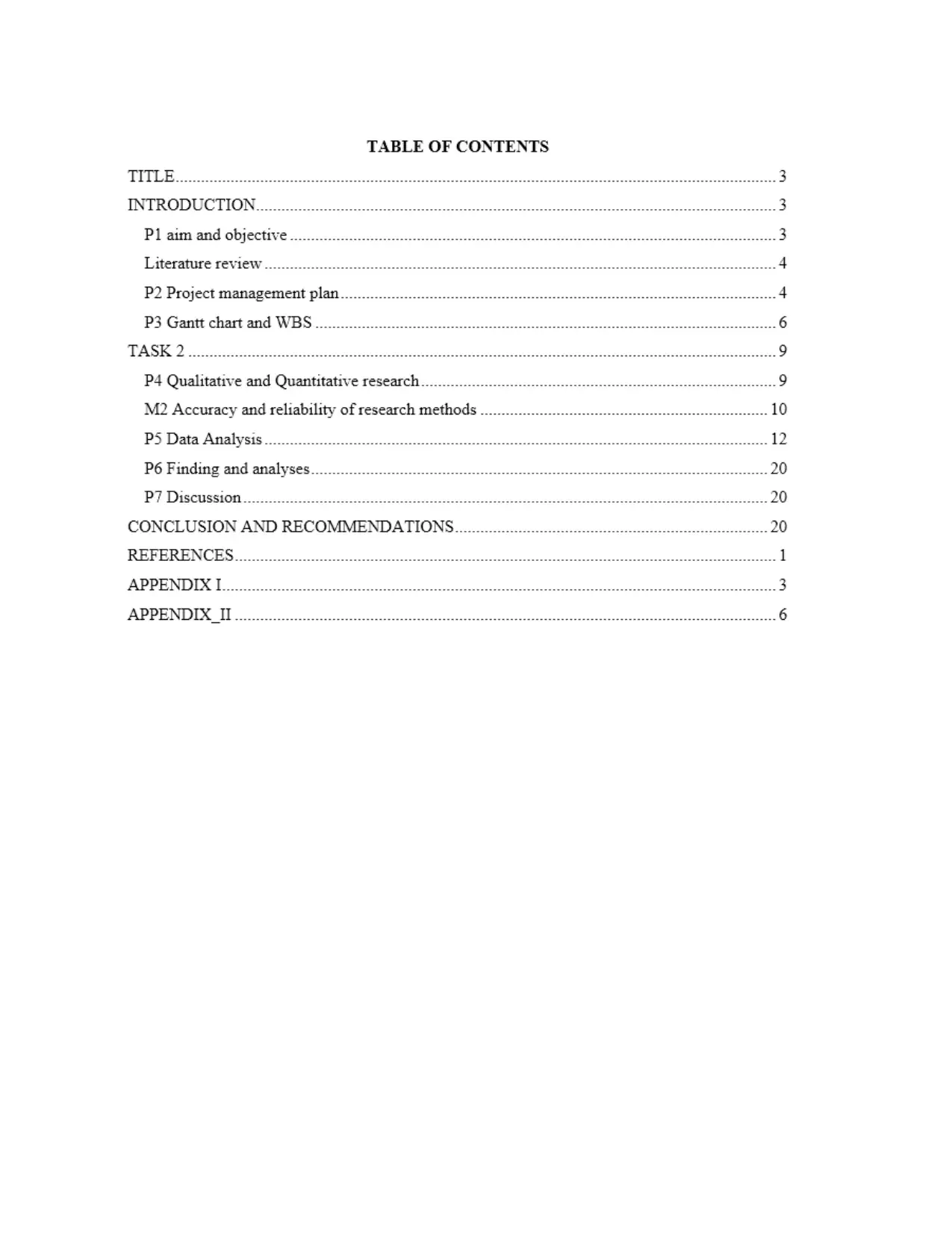
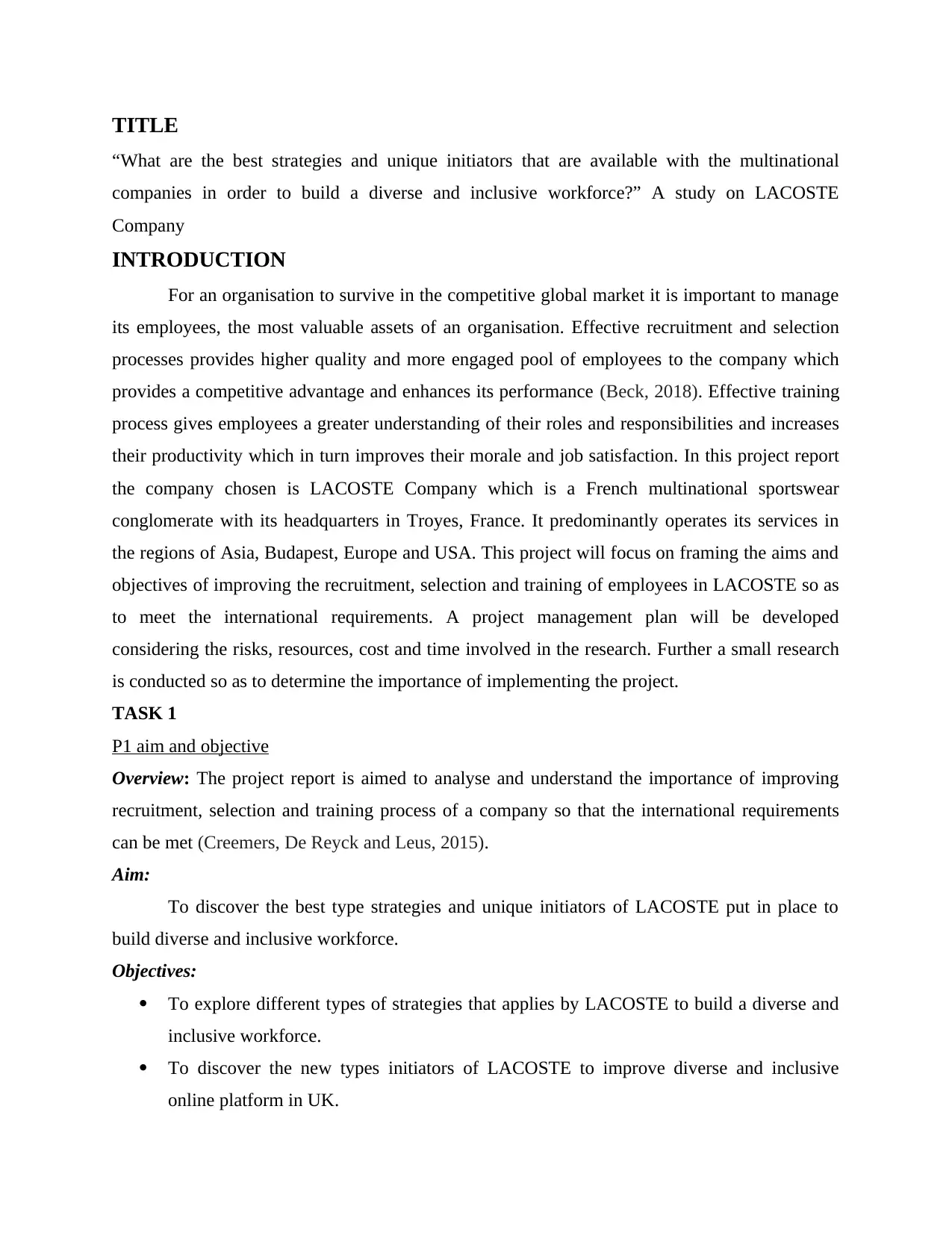
TITLE
“What are the best strategies and unique initiators that are available with the multinational
companies in order to build a diverse and inclusive workforce?” A study on LACOSTE
Company
INTRODUCTION
For an organisation to survive in the competitive global market it is important to manage
its employees, the most valuable assets of an organisation. Effective recruitment and selection
processes provides higher quality and more engaged pool of employees to the company which
provides a competitive advantage and enhances its performance (Beck, 2018). Effective training
process gives employees a greater understanding of their roles and responsibilities and increases
their productivity which in turn improves their morale and job satisfaction. In this project report
the company chosen is LACOSTE Company which is a French multinational sportswear
conglomerate with its headquarters in Troyes, France. It predominantly operates its services in
the regions of Asia, Budapest, Europe and USA. This project will focus on framing the aims and
objectives of improving the recruitment, selection and training of employees in LACOSTE so as
to meet the international requirements. A project management plan will be developed
considering the risks, resources, cost and time involved in the research. Further a small research
is conducted so as to determine the importance of implementing the project.
TASK 1
P1 aim and objective
Overview: The project report is aimed to analyse and understand the importance of improving
recruitment, selection and training process of a company so that the international requirements
can be met (Creemers, De Reyck and Leus, 2015).
Aim:
To discover the best type strategies and unique initiators of LACOSTE put in place to
build diverse and inclusive workforce.
Objectives:
To explore different types of strategies that applies by LACOSTE to build a diverse and
inclusive workforce.
To discover the new types initiators of LACOSTE to improve diverse and inclusive
online platform in UK.
“What are the best strategies and unique initiators that are available with the multinational
companies in order to build a diverse and inclusive workforce?” A study on LACOSTE
Company
INTRODUCTION
For an organisation to survive in the competitive global market it is important to manage
its employees, the most valuable assets of an organisation. Effective recruitment and selection
processes provides higher quality and more engaged pool of employees to the company which
provides a competitive advantage and enhances its performance (Beck, 2018). Effective training
process gives employees a greater understanding of their roles and responsibilities and increases
their productivity which in turn improves their morale and job satisfaction. In this project report
the company chosen is LACOSTE Company which is a French multinational sportswear
conglomerate with its headquarters in Troyes, France. It predominantly operates its services in
the regions of Asia, Budapest, Europe and USA. This project will focus on framing the aims and
objectives of improving the recruitment, selection and training of employees in LACOSTE so as
to meet the international requirements. A project management plan will be developed
considering the risks, resources, cost and time involved in the research. Further a small research
is conducted so as to determine the importance of implementing the project.
TASK 1
P1 aim and objective
Overview: The project report is aimed to analyse and understand the importance of improving
recruitment, selection and training process of a company so that the international requirements
can be met (Creemers, De Reyck and Leus, 2015).
Aim:
To discover the best type strategies and unique initiators of LACOSTE put in place to
build diverse and inclusive workforce.
Objectives:
To explore different types of strategies that applies by LACOSTE to build a diverse and
inclusive workforce.
To discover the new types initiators of LACOSTE to improve diverse and inclusive
online platform in UK.
⊘ This is a preview!⊘
Do you want full access?
Subscribe today to unlock all pages.

Trusted by 1+ million students worldwide
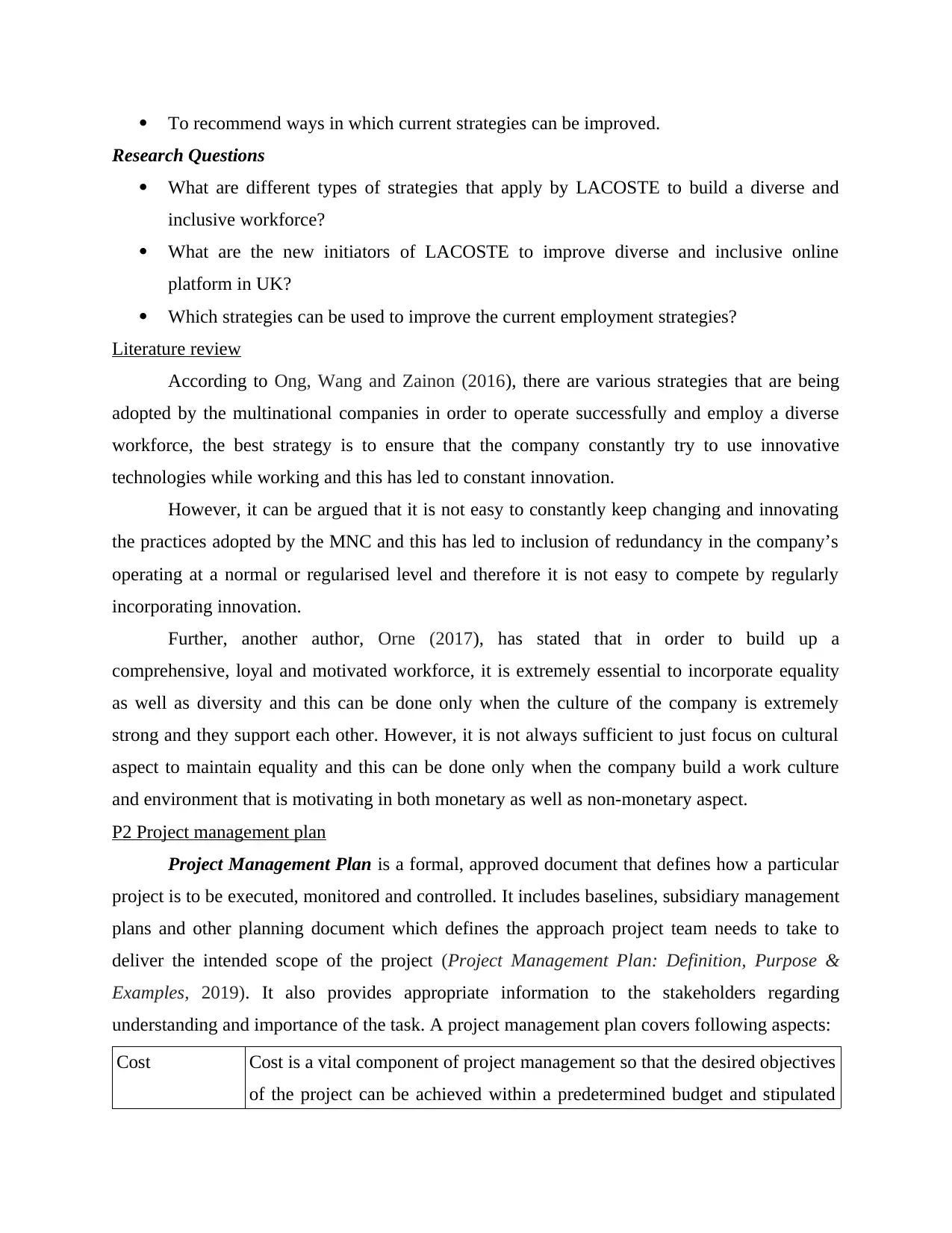
To recommend ways in which current strategies can be improved.
Research Questions
What are different types of strategies that apply by LACOSTE to build a diverse and
inclusive workforce?
What are the new initiators of LACOSTE to improve diverse and inclusive online
platform in UK?
Which strategies can be used to improve the current employment strategies?
Literature review
According to Ong, Wang and Zainon (2016), there are various strategies that are being
adopted by the multinational companies in order to operate successfully and employ a diverse
workforce, the best strategy is to ensure that the company constantly try to use innovative
technologies while working and this has led to constant innovation.
However, it can be argued that it is not easy to constantly keep changing and innovating
the practices adopted by the MNC and this has led to inclusion of redundancy in the company’s
operating at a normal or regularised level and therefore it is not easy to compete by regularly
incorporating innovation.
Further, another author, Orne (2017), has stated that in order to build up a
comprehensive, loyal and motivated workforce, it is extremely essential to incorporate equality
as well as diversity and this can be done only when the culture of the company is extremely
strong and they support each other. However, it is not always sufficient to just focus on cultural
aspect to maintain equality and this can be done only when the company build a work culture
and environment that is motivating in both monetary as well as non-monetary aspect.
P2 Project management plan
Project Management Plan is a formal, approved document that defines how a particular
project is to be executed, monitored and controlled. It includes baselines, subsidiary management
plans and other planning document which defines the approach project team needs to take to
deliver the intended scope of the project (Project Management Plan: Definition, Purpose &
Examples, 2019). It also provides appropriate information to the stakeholders regarding
understanding and importance of the task. A project management plan covers following aspects:
Cost Cost is a vital component of project management so that the desired objectives
of the project can be achieved within a predetermined budget and stipulated
Research Questions
What are different types of strategies that apply by LACOSTE to build a diverse and
inclusive workforce?
What are the new initiators of LACOSTE to improve diverse and inclusive online
platform in UK?
Which strategies can be used to improve the current employment strategies?
Literature review
According to Ong, Wang and Zainon (2016), there are various strategies that are being
adopted by the multinational companies in order to operate successfully and employ a diverse
workforce, the best strategy is to ensure that the company constantly try to use innovative
technologies while working and this has led to constant innovation.
However, it can be argued that it is not easy to constantly keep changing and innovating
the practices adopted by the MNC and this has led to inclusion of redundancy in the company’s
operating at a normal or regularised level and therefore it is not easy to compete by regularly
incorporating innovation.
Further, another author, Orne (2017), has stated that in order to build up a
comprehensive, loyal and motivated workforce, it is extremely essential to incorporate equality
as well as diversity and this can be done only when the culture of the company is extremely
strong and they support each other. However, it is not always sufficient to just focus on cultural
aspect to maintain equality and this can be done only when the company build a work culture
and environment that is motivating in both monetary as well as non-monetary aspect.
P2 Project management plan
Project Management Plan is a formal, approved document that defines how a particular
project is to be executed, monitored and controlled. It includes baselines, subsidiary management
plans and other planning document which defines the approach project team needs to take to
deliver the intended scope of the project (Project Management Plan: Definition, Purpose &
Examples, 2019). It also provides appropriate information to the stakeholders regarding
understanding and importance of the task. A project management plan covers following aspects:
Cost Cost is a vital component of project management so that the desired objectives
of the project can be achieved within a predetermined budget and stipulated
Paraphrase This Document
Need a fresh take? Get an instant paraphrase of this document with our AI Paraphraser
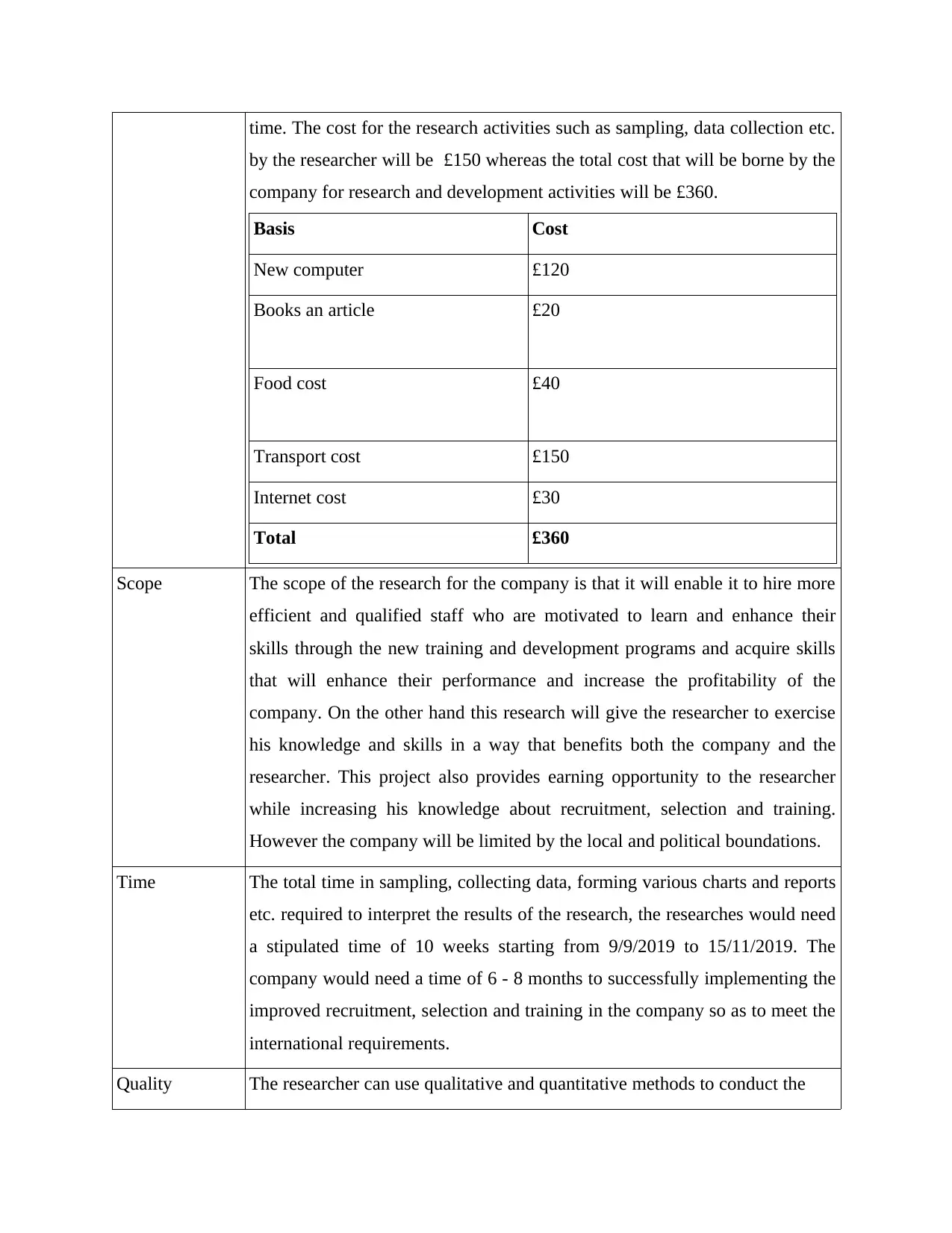
time. The cost for the research activities such as sampling, data collection etc.
by the researcher will be £150 whereas the total cost that will be borne by the
company for research and development activities will be £360.
Basis Cost
New computer £120
Books an article £20
Food cost £40
Transport cost £150
Internet cost £30
Total £360
Scope The scope of the research for the company is that it will enable it to hire more
efficient and qualified staff who are motivated to learn and enhance their
skills through the new training and development programs and acquire skills
that will enhance their performance and increase the profitability of the
company. On the other hand this research will give the researcher to exercise
his knowledge and skills in a way that benefits both the company and the
researcher. This project also provides earning opportunity to the researcher
while increasing his knowledge about recruitment, selection and training.
However the company will be limited by the local and political boundations.
Time The total time in sampling, collecting data, forming various charts and reports
etc. required to interpret the results of the research, the researches would need
a stipulated time of 10 weeks starting from 9/9/2019 to 15/11/2019. The
company would need a time of 6 - 8 months to successfully implementing the
improved recruitment, selection and training in the company so as to meet the
international requirements.
Quality The researcher can use qualitative and quantitative methods to conduct the
by the researcher will be £150 whereas the total cost that will be borne by the
company for research and development activities will be £360.
Basis Cost
New computer £120
Books an article £20
Food cost £40
Transport cost £150
Internet cost £30
Total £360
Scope The scope of the research for the company is that it will enable it to hire more
efficient and qualified staff who are motivated to learn and enhance their
skills through the new training and development programs and acquire skills
that will enhance their performance and increase the profitability of the
company. On the other hand this research will give the researcher to exercise
his knowledge and skills in a way that benefits both the company and the
researcher. This project also provides earning opportunity to the researcher
while increasing his knowledge about recruitment, selection and training.
However the company will be limited by the local and political boundations.
Time The total time in sampling, collecting data, forming various charts and reports
etc. required to interpret the results of the research, the researches would need
a stipulated time of 10 weeks starting from 9/9/2019 to 15/11/2019. The
company would need a time of 6 - 8 months to successfully implementing the
improved recruitment, selection and training in the company so as to meet the
international requirements.
Quality The researcher can use qualitative and quantitative methods to conduct the
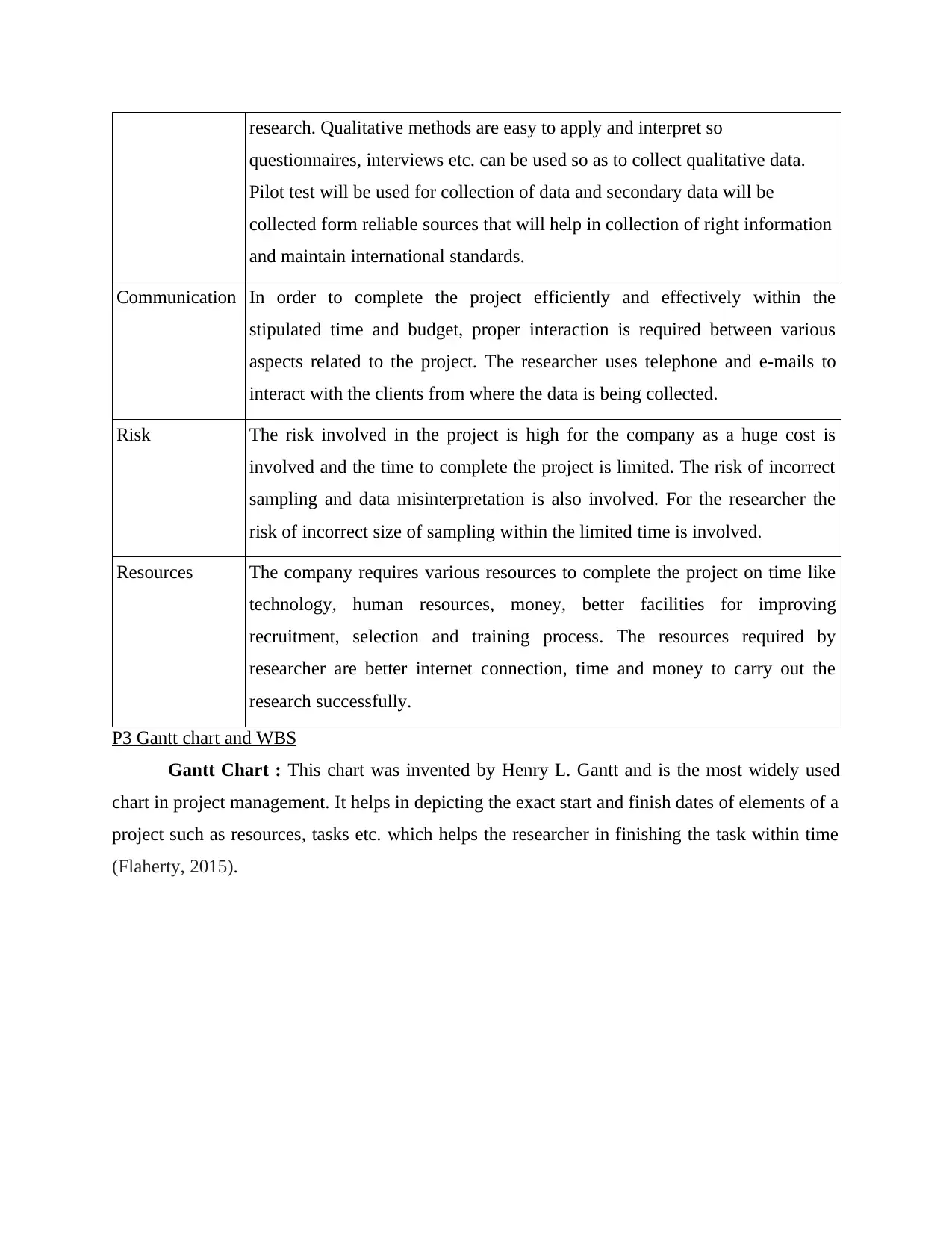
research. Qualitative methods are easy to apply and interpret so
questionnaires, interviews etc. can be used so as to collect qualitative data.
Pilot test will be used for collection of data and secondary data will be
collected form reliable sources that will help in collection of right information
and maintain international standards.
Communication In order to complete the project efficiently and effectively within the
stipulated time and budget, proper interaction is required between various
aspects related to the project. The researcher uses telephone and e-mails to
interact with the clients from where the data is being collected.
Risk The risk involved in the project is high for the company as a huge cost is
involved and the time to complete the project is limited. The risk of incorrect
sampling and data misinterpretation is also involved. For the researcher the
risk of incorrect size of sampling within the limited time is involved.
Resources The company requires various resources to complete the project on time like
technology, human resources, money, better facilities for improving
recruitment, selection and training process. The resources required by
researcher are better internet connection, time and money to carry out the
research successfully.
P3 Gantt chart and WBS
Gantt Chart : This chart was invented by Henry L. Gantt and is the most widely used
chart in project management. It helps in depicting the exact start and finish dates of elements of a
project such as resources, tasks etc. which helps the researcher in finishing the task within time
(Flaherty, 2015).
questionnaires, interviews etc. can be used so as to collect qualitative data.
Pilot test will be used for collection of data and secondary data will be
collected form reliable sources that will help in collection of right information
and maintain international standards.
Communication In order to complete the project efficiently and effectively within the
stipulated time and budget, proper interaction is required between various
aspects related to the project. The researcher uses telephone and e-mails to
interact with the clients from where the data is being collected.
Risk The risk involved in the project is high for the company as a huge cost is
involved and the time to complete the project is limited. The risk of incorrect
sampling and data misinterpretation is also involved. For the researcher the
risk of incorrect size of sampling within the limited time is involved.
Resources The company requires various resources to complete the project on time like
technology, human resources, money, better facilities for improving
recruitment, selection and training process. The resources required by
researcher are better internet connection, time and money to carry out the
research successfully.
P3 Gantt chart and WBS
Gantt Chart : This chart was invented by Henry L. Gantt and is the most widely used
chart in project management. It helps in depicting the exact start and finish dates of elements of a
project such as resources, tasks etc. which helps the researcher in finishing the task within time
(Flaherty, 2015).
⊘ This is a preview!⊘
Do you want full access?
Subscribe today to unlock all pages.

Trusted by 1+ million students worldwide
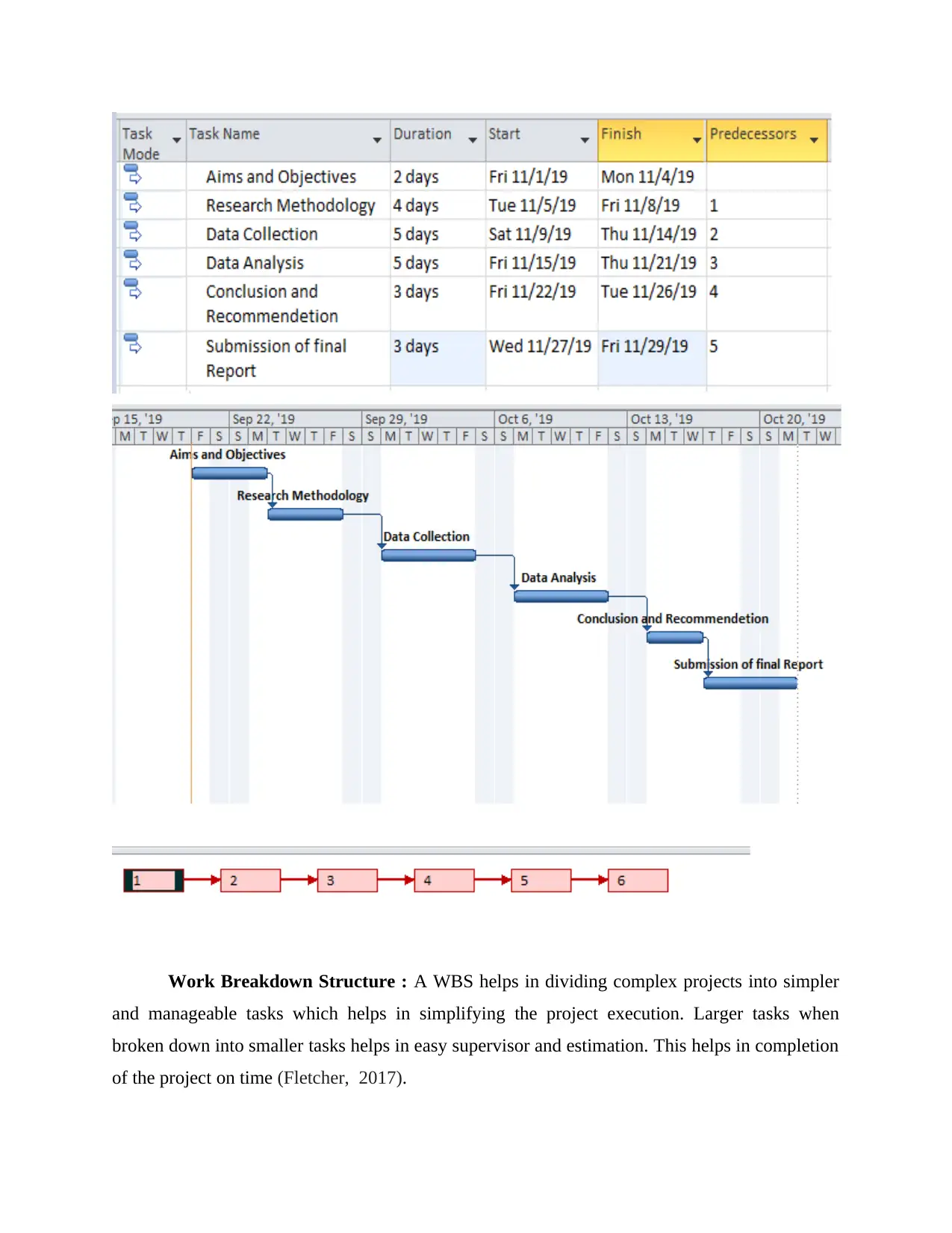
Work Breakdown Structure : A WBS helps in dividing complex projects into simpler
and manageable tasks which helps in simplifying the project execution. Larger tasks when
broken down into smaller tasks helps in easy supervisor and estimation. This helps in completion
of the project on time (Fletcher, 2017).
and manageable tasks which helps in simplifying the project execution. Larger tasks when
broken down into smaller tasks helps in easy supervisor and estimation. This helps in completion
of the project on time (Fletcher, 2017).
Paraphrase This Document
Need a fresh take? Get an instant paraphrase of this document with our AI Paraphraser
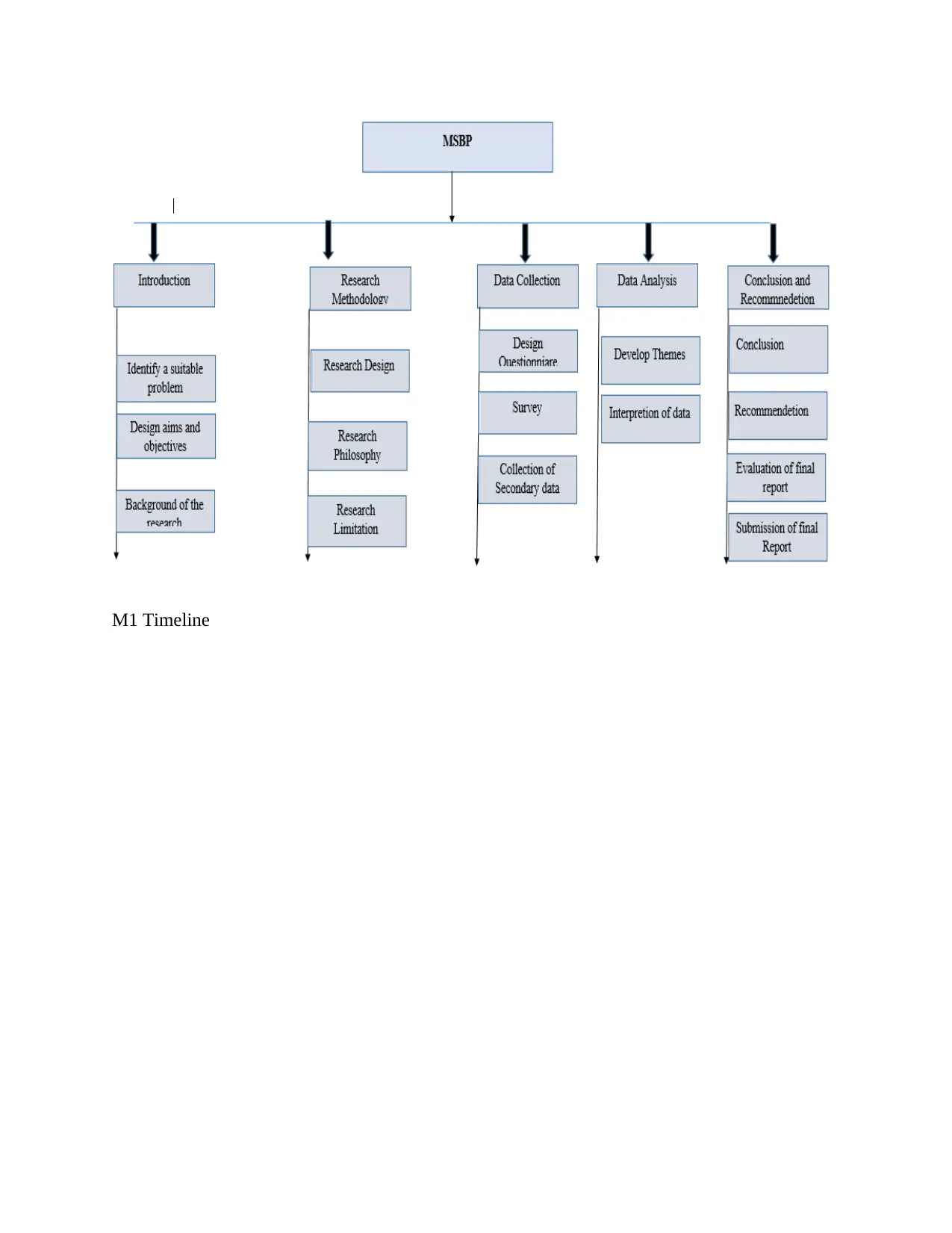
M1 Timeline
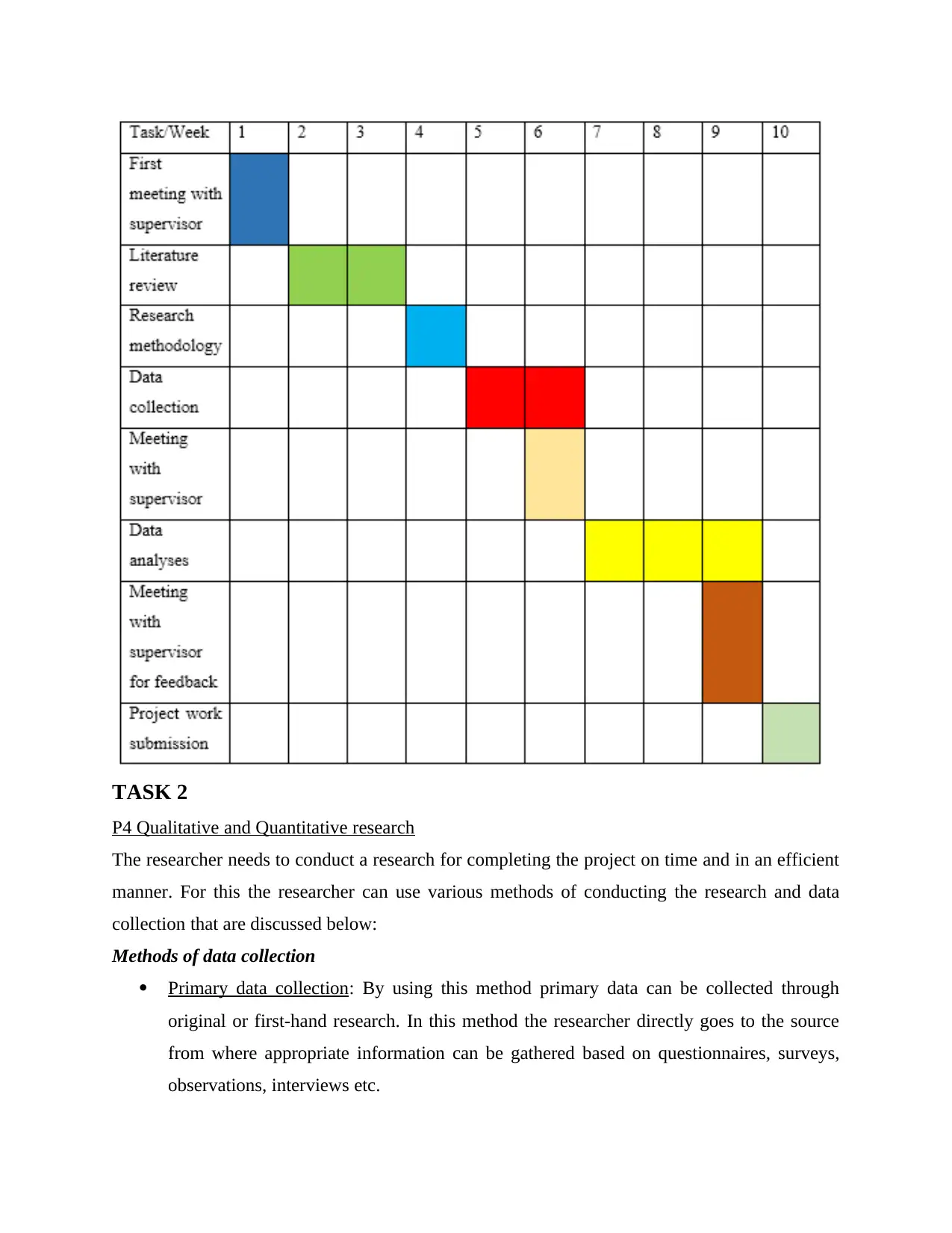
TASK 2
P4 Qualitative and Quantitative research
The researcher needs to conduct a research for completing the project on time and in an efficient
manner. For this the researcher can use various methods of conducting the research and data
collection that are discussed below:
Methods of data collection
Primary data collection: By using this method primary data can be collected through
original or first-hand research. In this method the researcher directly goes to the source
from where appropriate information can be gathered based on questionnaires, surveys,
observations, interviews etc.
P4 Qualitative and Quantitative research
The researcher needs to conduct a research for completing the project on time and in an efficient
manner. For this the researcher can use various methods of conducting the research and data
collection that are discussed below:
Methods of data collection
Primary data collection: By using this method primary data can be collected through
original or first-hand research. In this method the researcher directly goes to the source
from where appropriate information can be gathered based on questionnaires, surveys,
observations, interviews etc.
⊘ This is a preview!⊘
Do you want full access?
Subscribe today to unlock all pages.

Trusted by 1+ million students worldwide
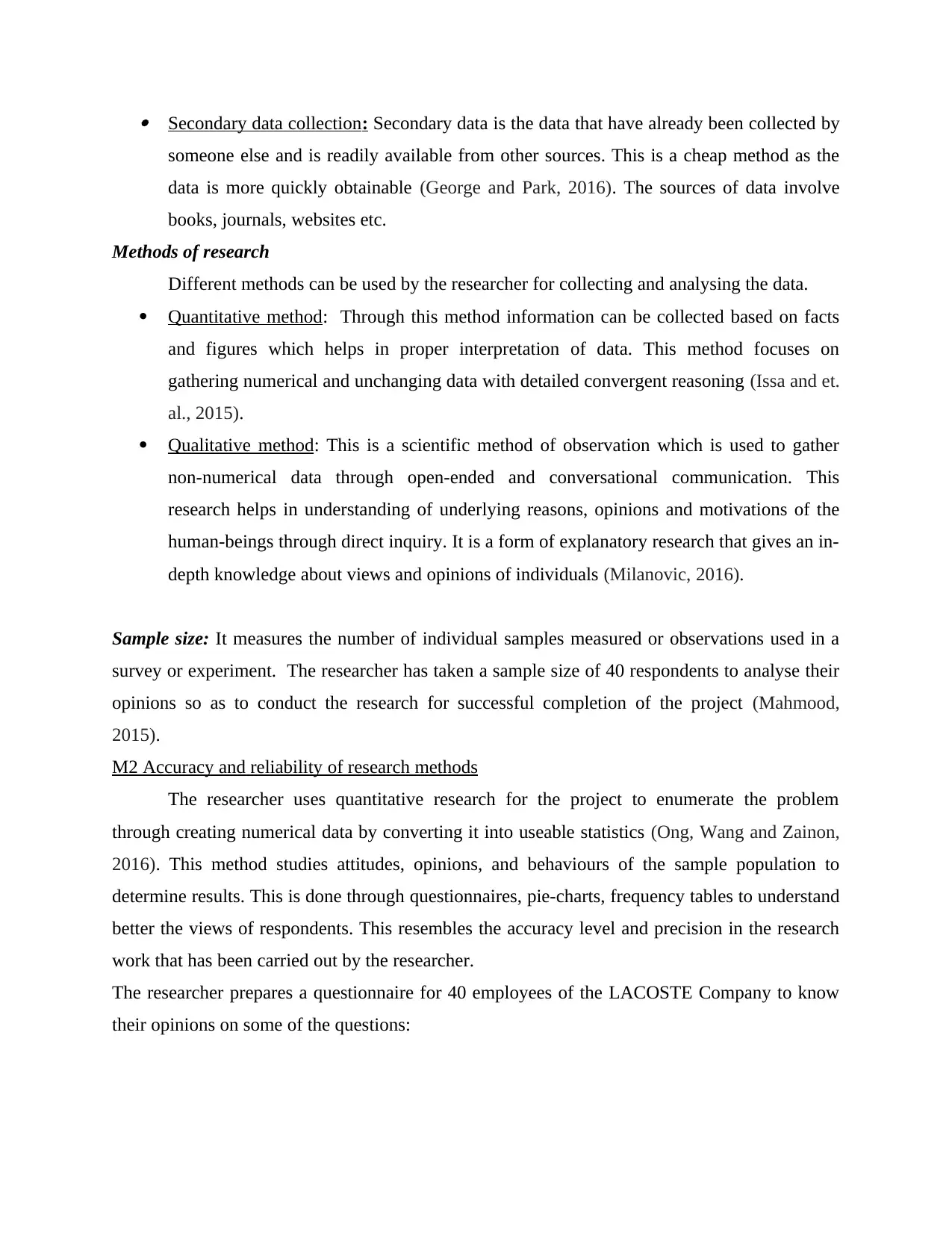
Secondary data collection: Secondary data is the data that have already been collected by
someone else and is readily available from other sources. This is a cheap method as the
data is more quickly obtainable (George and Park, 2016). The sources of data involve
books, journals, websites etc.
Methods of research
Different methods can be used by the researcher for collecting and analysing the data.
Quantitative method: Through this method information can be collected based on facts
and figures which helps in proper interpretation of data. This method focuses on
gathering numerical and unchanging data with detailed convergent reasoning (Issa and et.
al., 2015).
Qualitative method: This is a scientific method of observation which is used to gather
non-numerical data through open-ended and conversational communication. This
research helps in understanding of underlying reasons, opinions and motivations of the
human-beings through direct inquiry. It is a form of explanatory research that gives an in-
depth knowledge about views and opinions of individuals (Milanovic, 2016).
Sample size: It measures the number of individual samples measured or observations used in a
survey or experiment. The researcher has taken a sample size of 40 respondents to analyse their
opinions so as to conduct the research for successful completion of the project (Mahmood,
2015).
M2 Accuracy and reliability of research methods
The researcher uses quantitative research for the project to enumerate the problem
through creating numerical data by converting it into useable statistics (Ong, Wang and Zainon,
2016). This method studies attitudes, opinions, and behaviours of the sample population to
determine results. This is done through questionnaires, pie-charts, frequency tables to understand
better the views of respondents. This resembles the accuracy level and precision in the research
work that has been carried out by the researcher.
The researcher prepares a questionnaire for 40 employees of the LACOSTE Company to know
their opinions on some of the questions:
someone else and is readily available from other sources. This is a cheap method as the
data is more quickly obtainable (George and Park, 2016). The sources of data involve
books, journals, websites etc.
Methods of research
Different methods can be used by the researcher for collecting and analysing the data.
Quantitative method: Through this method information can be collected based on facts
and figures which helps in proper interpretation of data. This method focuses on
gathering numerical and unchanging data with detailed convergent reasoning (Issa and et.
al., 2015).
Qualitative method: This is a scientific method of observation which is used to gather
non-numerical data through open-ended and conversational communication. This
research helps in understanding of underlying reasons, opinions and motivations of the
human-beings through direct inquiry. It is a form of explanatory research that gives an in-
depth knowledge about views and opinions of individuals (Milanovic, 2016).
Sample size: It measures the number of individual samples measured or observations used in a
survey or experiment. The researcher has taken a sample size of 40 respondents to analyse their
opinions so as to conduct the research for successful completion of the project (Mahmood,
2015).
M2 Accuracy and reliability of research methods
The researcher uses quantitative research for the project to enumerate the problem
through creating numerical data by converting it into useable statistics (Ong, Wang and Zainon,
2016). This method studies attitudes, opinions, and behaviours of the sample population to
determine results. This is done through questionnaires, pie-charts, frequency tables to understand
better the views of respondents. This resembles the accuracy level and precision in the research
work that has been carried out by the researcher.
The researcher prepares a questionnaire for 40 employees of the LACOSTE Company to know
their opinions on some of the questions:
Paraphrase This Document
Need a fresh take? Get an instant paraphrase of this document with our AI Paraphraser
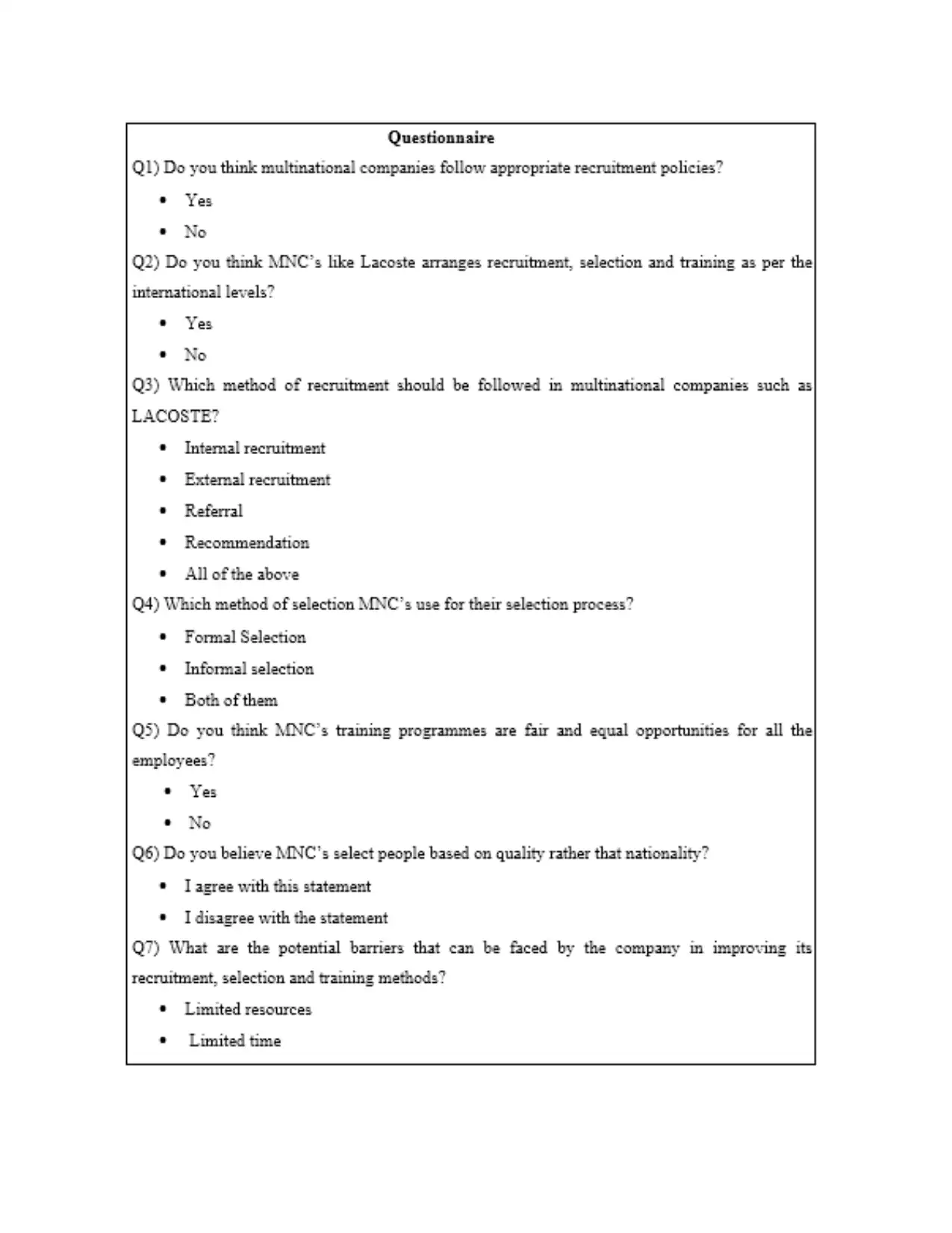
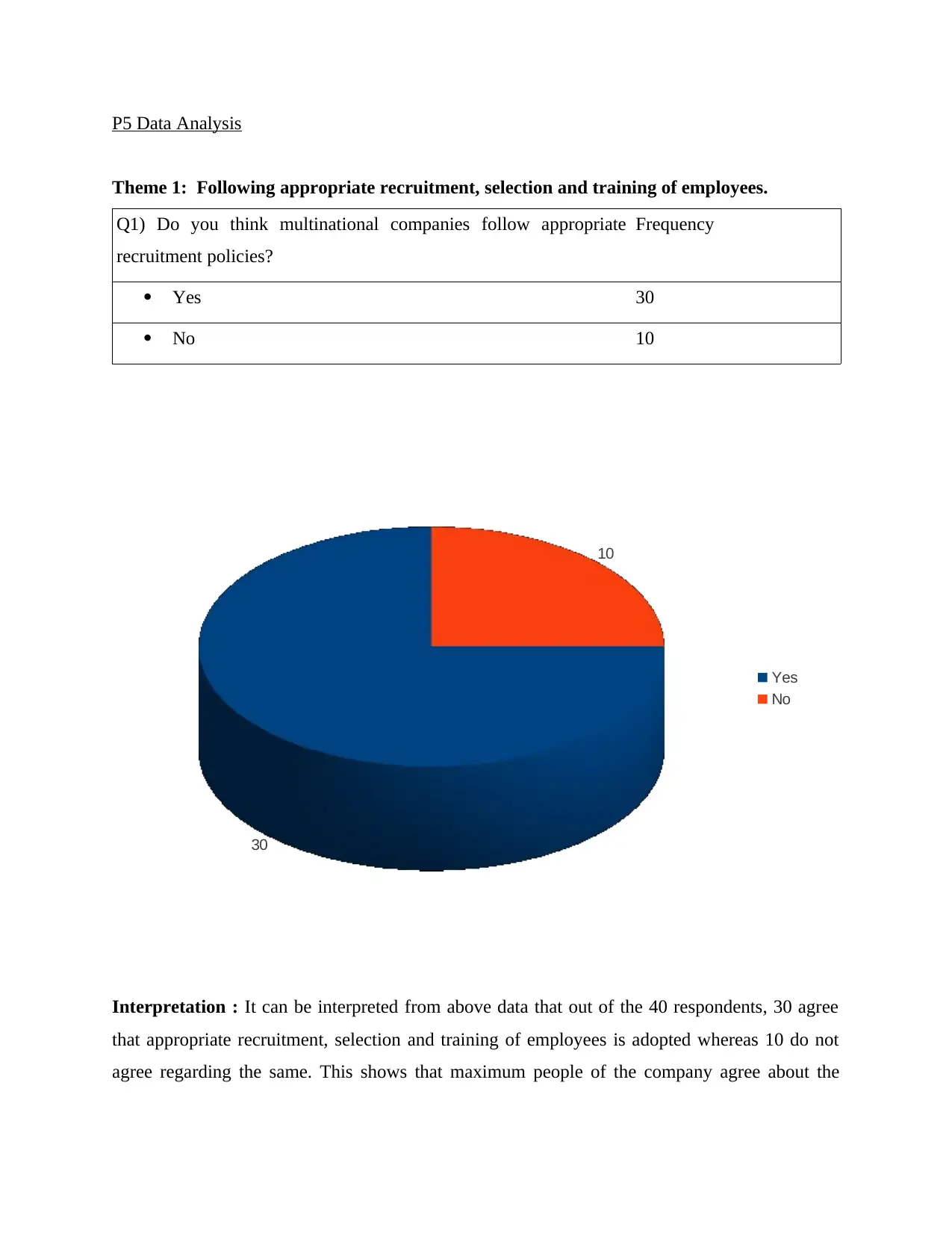
P5 Data Analysis
Theme 1: Following appropriate recruitment, selection and training of employees.
Q1) Do you think multinational companies follow appropriate
recruitment policies?
Frequency
Yes 30
No 10
30
10
Yes
No
Interpretation : It can be interpreted from above data that out of the 40 respondents, 30 agree
that appropriate recruitment, selection and training of employees is adopted whereas 10 do not
agree regarding the same. This shows that maximum people of the company agree about the
Theme 1: Following appropriate recruitment, selection and training of employees.
Q1) Do you think multinational companies follow appropriate
recruitment policies?
Frequency
Yes 30
No 10
30
10
Yes
No
Interpretation : It can be interpreted from above data that out of the 40 respondents, 30 agree
that appropriate recruitment, selection and training of employees is adopted whereas 10 do not
agree regarding the same. This shows that maximum people of the company agree about the
⊘ This is a preview!⊘
Do you want full access?
Subscribe today to unlock all pages.

Trusted by 1+ million students worldwide
1 out of 28
Related Documents
Your All-in-One AI-Powered Toolkit for Academic Success.
+13062052269
info@desklib.com
Available 24*7 on WhatsApp / Email
![[object Object]](/_next/static/media/star-bottom.7253800d.svg)
Unlock your academic potential
Copyright © 2020–2025 A2Z Services. All Rights Reserved. Developed and managed by ZUCOL.





